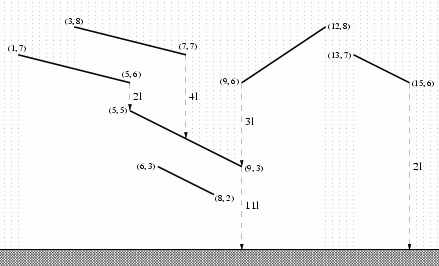本文主要是介绍【POJ 1765】 November Rain(离散化+扫描线),希望对大家解决编程问题提供一定的参考价值,需要的开发者们随着小编来一起学习吧!
【POJ 1765】 November Rain(离散化+扫描线)
| Time Limit: 5000MS | Memory Limit: 65536K | |
| Total Submissions: 2193 | Accepted: 472 | |
| Case Time Limit: 2000MS | ||
Description

For the purpose of designing a piping system it is desired to compute how much water is down from each segment of the roof. To be prepared for a heavy November rain you should count one liter of rain water falling on a meter of the horizontal plane during one second.
Task
Write a program that:
reads the description of a roof,
computes the amount of water down in one second from each segment of the roof,
writes the results.
Input
Output
Sample Input
6 13 7 15 6 3 8 7 7 1 7 5 6 5 5 9 3 6 3 8 2 9 6 12 8
Sample Output
2 4 2 11 0 3
题目大意:有n个屋檐 求积水量
积水量是指横向累计的水流长度(水流在该屋檐上覆盖的横坐标长度)
对于每个屋檐,还要累计上它上面的屋檐流下来的水量。
样例挺友好的,看样例看图应该就能明白
至于写法,我没用线段树维护。
先不考虑上面流下来的水量,从左往右,每当到一个新的横坐标,前一个横坐标到当前累计的水量会统计到当前位置最高的屋檐上。
题目中说同一个横坐标最多25个屋檐,那么就暴力啊……
对于流下来的水。在刚才跑的过程中,建立拓扑图,随便什么方法,建出来就好
然后从最上面流下来就好。。
代码如下:
#include <iostream>
#include <cmath>
#include <vector>
#include <cstdlib>
#include <cstdio>
#include <cstring>
#include <queue>
#include <stack>
#include <list>
#include <algorithm>
#include <map>
#include <set>
#define LL long long
#define Pr pair<int,int>
#define fread() freopen("in.in","r",stdin)
#define fwrite() freopen("out.out","w",stdout)using namespace std;
const int INF = 0x3f3f3f3f;
const int msz = 10000;
const int mod = 1e9+7;
const double eps = 1e-8;struct Point
{LL x,y,id;bool ad;bool operator <(const struct Point a)const{return x == a.x? ad == a.ad? ad == 1? y < a.y: y > a.y: ad > a.ad: x < a.x;}
};int tmp[233];
bool vis[233];
Point pt[88888];
Point ptc[88888];
int down[88888];
int up[88888];
LL ans[44444];
int tp;double cal(int pos,LL x)
{pos <<= 1;return (pt[pos+1].y-pt[pos].y)*(x-pt[pos].x)*1.0/(pt[pos+1].x-pt[pos].x)+pt[pos].y;
}int main()
{//fread();//fwrite();int n;while(~scanf("%d",&n)){int tpp = 0;for(int i = 0; i < n; ++i){scanf("%lld%lld",&pt[tpp].x,&pt[tpp].y);pt[tpp].id = i;pt[tpp].ad = 1;ptc[tpp] = pt[tpp];tpp++;scanf("%lld%lld",&pt[tpp].x,&pt[tpp].y);pt[tpp].id = i;pt[tpp].ad = 0;ptc[tpp] = pt[tpp];tpp++;}sort(ptc,ptc+tpp);memset(ans,0,sizeof(ans));memset(vis,0,sizeof(vis));memset(down,-1,sizeof(down));memset(up,0,sizeof(up));tp = 0;int j,mx;for(int i = 0; i < tpp; ++i){//printf("------Step:%d x:%d y:%d---------\n",i,ptc[i].x,ptc[i].y);int id = ptc[i].id;if(i != 0 && ptc[i].x != ptc[i-1].x){mx = -1;for(j = 0; j < tp; ++j){if(!vis[j]) continue;if(mx == -1 || cal(tmp[j],ptc[i].x) > cal(mx,ptc[i].x)) mx = tmp[j];}//printf("mx:%d\n",mx);//printf("%d-%d %d-%d\n",pt[mx<<1].x,pt[mx<<1].y,pt[mx<<1|1].x,pt[mx<<1|1].y);if(mx != -1) ans[mx] += ptc[i].x-ptc[i-1].x;}mx = -1;if(ptc[i].ad){if(pt[id<<1].y < pt[id<<1|1].y){for(j = 0; j < tp; ++j){if(!vis[j]) continue;//printf("cmp:%f %d\n",cal(tmp[j],ptc[i].x),ptc[i].y);if(cal(tmp[j],ptc[i].x) < ptc[i].y*1.0 && (mx == -1 || cal(tmp[j],ptc[i].x) > cal(mx,ptc[i].x))) mx = tmp[j];}if(mx != -1){//printf("!!!!!!!!!get:%d\n",mx);down[id] = mx;up[mx]++;}}for(j = 0; j < tp; ++j)if(!vis[j]) break;if(j == tp) tmp[tp++] = id;else tmp[j] = id;vis[j] = 1;}else{for(j = 0; j < tp; ++j)if(vis[j] && tmp[j] == id) break;if(j == tp) --tp;vis[j] = 0;if(pt[id<<1].y > pt[id<<1|1].y){for(j = 0; j < tp; ++j){if(!vis[j]) continue;//printf("cmp:%f %d\n",cal(tmp[j],ptc[i].x),ptc[i].y);if(cal(tmp[j],ptc[i].x) < ptc[i].y*1.0 && (mx == -1 || cal(tmp[j],ptc[i].x) > cal(mx,ptc[i].x))) mx = tmp[j];}if(mx != -1){//printf("!!!!!!!!!get:%d\n",mx);down[id] = mx;up[mx]++;}}}}for(int i = 0; i < n; ++i){if(!up[i]){//printf("ID:%d\n",i);int id = i;LL ad = ans[i];while(down[id] != -1){ans[down[id]] += ad;up[down[id]]--;if(up[down[id]] > 0){break;}else up[down[id]]--;ad = ans[down[id]];id = down[id];}}}for(int i = 0; i < n; ++i)printf("%lld\n",ans[i]);}return 0;
}
这篇关于【POJ 1765】 November Rain(离散化+扫描线)的文章就介绍到这儿,希望我们推荐的文章对编程师们有所帮助!




